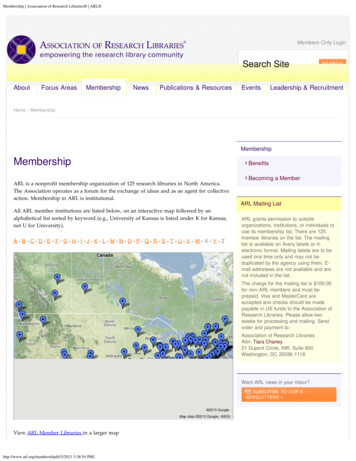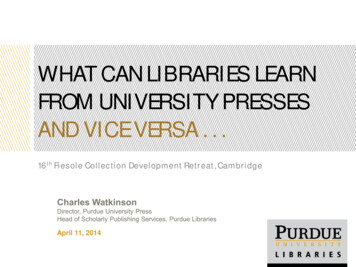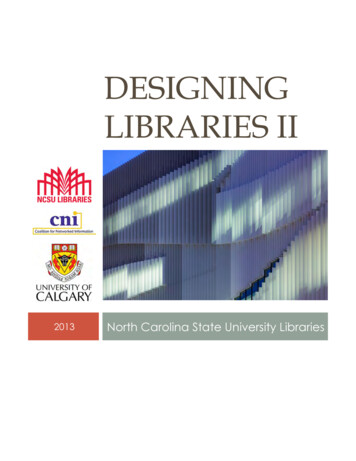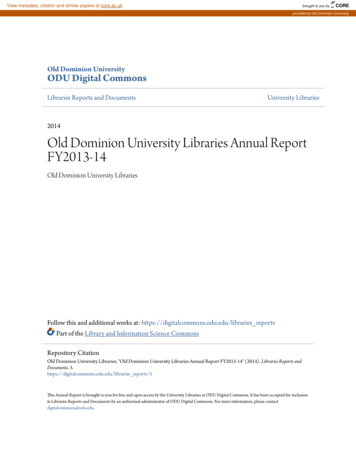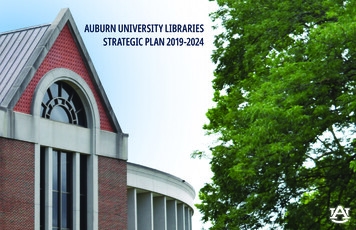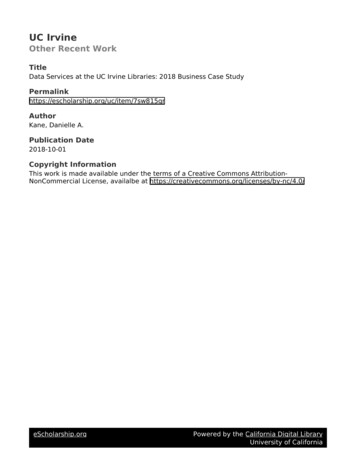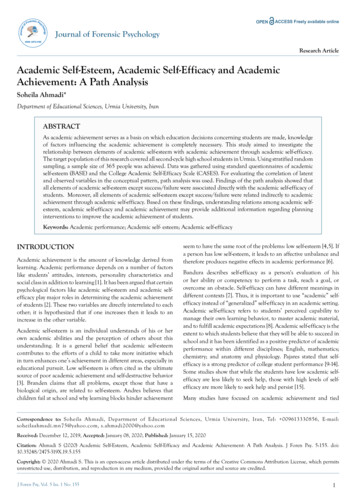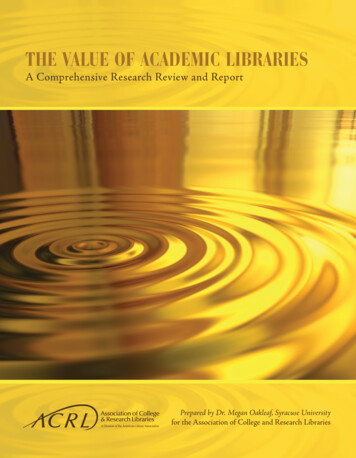
Transcription
THE VALUE OF ACADEMIC LIBRARIESA Comprehensive Research Review and ReportPrepared by Dr. Megan Oakleaf, Syracuse Universityfor the Association of College and Research Libraries
Value of Academic Libraries: A Comprehensive Research Review and ReportMegan Oakleaf for the Association of College and Research Libraries (ACRL)ISBN: 978-0-8389-8568-7 2010 American Library AssociationAll Rights ReservedSeptember 2010Association of College and Research LibrariesA Division of the American Library Association50 E. Huron St.Chicago, IL 60611Citation:Association of College and Research Libraries. Value of Academic Libraries: AComprehensive Research Review and Report. Researched by Megan Oakleaf.Chicago: Association of College and Research Libraries, 2010.Published online at www.acrl.ala.org/valueValue of Academic LibrariesPage 2
Value of Academic Libraries:A Comprehensive Research Review and ReportPrepared by Megan Oakleaffor the Association of College and Research LibrariesAdvisory Committee: Debra Gilchrist, Bruce Kingma, Martha Kyrillidou, George KuhAssistant Researchers: Patricia L. Owen, Leah Sopchak, Anna Dahlstein, Tamika BarnesTable of ContentsFOREWORD . 6EXECUTIVE SUMMARY .11DEFINING “VALUE” .20METHODOLOGY .25REVIEW AND ANALYSIS OF THE LITERATURE .26Academic Library .26Expectations of Higher Education .26Reconceptualizing Academic Libraries .28Achieving Institutional Missions and Outcomes .29Assessment vs. Research .30Student Retention and Graduation Rates .32Student Engagement.35Student Learning .37Assessment Management Systems .45Faculty Teaching .46Faculty Research .47Library Valuation .49Reference Services .49E-Resources .50Institutional Ranking .52What About Accreditation? .54Societal Contribution .55A Reminder Regarding Scope .56What’s Next for Academic Library Value Studies?.57Value of Academic LibrariesPage 3
School Libraries .58Working with Teachers and Principals .58Evidence-Based Practice and Action Research.59Assessment Tools .60Large-Scale Studies .65Assessment Management Systems .70Reporting Results.70What’s Next for School Library Value Studies? .71Public Libraries .72Economic Value .72Economic Benefit .75Economic Activity .77Economic Impact.77Social Impact .79What’s Next for Public Library Value Studies? .81Special Libraries .83Working with Managers .83Economic Studies .84Impact Studies .88Reporting Results.90What’s Next for Special Library Value Studies?.92WHAT TO DO NEXT .93Get Started.93Define Outcomes .94Use Assessment Management Systems .94Gather New Data .94Use Existing Data.97Engage in Higher Education Assessment External to Libraries .97Create Library Assessment Plans .98Mobilize Library Administrators .98Engage in Professional Development .99Leverage Professional Library Associations .100RESEARCH AGENDA .101Value of Academic LibrariesPage 4
Student Enrollment .103Student Retention .106Student Success .109Student Achievement.114Student Learning .117Student Experience, Attitude, and Perception of Quality .120Faculty Research Productivity.129Faculty Grants .132Faculty Teaching .134Institutional Reputation or Prestige .137CONCLUSION .140BIBLIOGRAPHY .141ACKNOWLEDGEMENTS.177APPENDIX A—ACADEMIC LIBRARY VALUE CHECKLIST .178APPENDIX B—“MUST READ” RESOURCES.181ABOUT ACRL .182Value of Academic LibrariesPage 5
FOREWORDLibrarians are increasingly called upon to document and articulate the value ofacademic and research libraries and their contribution to institutional mission and goals.ACRL’s Value of Academic Libraries Initiative responds to these demands and positionsacademic librarians as contributors to campus conversations on accountability andimpact. Quality of higher education continues to be a focus for national debate. Forexample, in early September The Chronicle of Higher Education launched a series,called the “Measuring Stick,” to explore the quality of higher education; in it the editors“hope to foster a conversation about how to assess colleges’ quality—and how not to.”Clearly calls for accountability will continue to influence the landscape of highereducation. To understand ACRL’s stake in this conversation, we start by looking at thisissue in the higher education perspective. We will then share with you ACRL’s plans tohelp librarians address the many questions about value and accountability.The National Conversation on Assessment, Accountability, and ValueSince the 1970s, higher education has adopted an increasingly managerial orientationin response to external calls for accountability. In 2006, under the Bush administration,the focus of the Spellings commission sent a strong message to higher education thatthe sector was being scrutinized. Some in academia feared that standards-basededucation reform similar to the K-12 No Child Left Behind Act would be legislated forhigher education. While many had hoped this climate would change under the Obamaadministration, four years later the pressure on higher education remains steady(Lederman, 2010a). Government interest in the effectiveness of higher education seemsto be increasing as the role of knowledge workers becomes more valuable incontributing to economic growth and national competitiveness. If policymakers in theUnited States emulate the Bologna process, with student learning as the primarymeasure of quality, it is likely that government regulation and calls for accountability willonly increase (Lederman, 2010b).Like any issue of national importance, there are a variety of perspectives through whichhigher education assessment, accountability, and value can be viewed. Manyassessment measures central to the accountability movement have been imported fromthe private sector and some in the academy feel that they do not work well with themission of higher education and academic libraries. Attempting to transfer corporatemanagement theory to colleges and universities (such as TQM, benchmarking,balanced scorecard, management for results, and other techniques adopted frombusiness) could readily offend some in a collegial culture who may meet them withprofound skepticism and even hostility (Bergquist and Pawlak, 2008). While profit is ameasurement one can quantify, understanding student learning, faculty scholarly work,and institutional quality require a much more nuanced approach, as some aspects maybe ineffable.Those critical of the assessment movement say there is danger in adopting marketplacestandards, rather than intellectual standards. Some point to the homogenizing effects ofspeedy and clear-cut measures of performance, believing it need not be inevitable thathigher education adopt these corporate values and practices (Currie and Newson,Value of Academic LibrariesPage 6
1998). Some go so far as to advocate that academics not even engage in designingappropriate performance indicators, as that would be tacit endorsement, but instead usetheir analytical and rhetorical skills to create counter narratives to these calls foraccountability or call for alternative approaches to demonstrating value (Polster andNewson, 1998).While we appreciate this critical perspective, such an approach seems impractical,given the realities we face today in our institutions. Moreover, we believe that, forlibraries and the institutions they serve, setting high standards and seeking to attainthem is not the same as standardization. As an association representing multiple typesof academic libraries, ACRL recognizes individual institutions have defined their values,and they must set goals, define outcomes, and assess them as is appropriate for localcontexts.Other scholars point to the internal paradox between assessment to improve academicprograms and assessment for external audiences designed to answer calls foraccountability from policymakers and the public. Assessing for internal improvementdepends on local context, while assessing to meet an external perspective focuses onfacts that are standardized and can be compared across institutions. Both have value,but conflating them leads to unintended consequences and perverse incentives(Borden, 2010). Such scholars would say that policymakers seeking unambiguous,concise, and quick accountability measures should refrain from an excessive focus onstate guidelines to assess student learning; instead they should delegate that hard workto the campuses, as it is already a faculty priority (Shulock, 2003).The “twin pillars” of twentieth-century higher education—collegial culture on the onehand and managerial culture on the other (Bergquist and Pawlak, 2008)—influence theways academic librarians approach their work. Librarians seek to protect the life of themind and defend knowledge for knowledge’s sake. At the same time, we strive to createeffective and efficient operations that are responsive to the needs of our faculty andstudents.While we are aware of these larger national conversations swirling through the highereducation and public policy sectors, this report is not intended to take sides in suchdebates. Consequently, this report takes a pragmatic approach; it lays out multipleassessment perspectives and invites librarians to adapt them to their localcircumstances. In the face of the evidence we see in today’s external policy and fundingclimate, we believe academic libraries, and the colleges and universities they serve, arenow and will continue to be compelled to participate in these conversations and findappropriate ways to show their value.ACRL’s Intention in Issuing this ReportIncreasing recognition of the value of libraries and librarians by leaders in highereducation, information technology, funding agencies, and campus decision making isone of ACRL’s six strategic priorities. ACRL has been listening to this nationalconversation on assessment, accountability, and value. Recognizing the sense ofValue of Academic LibrariesPage 7
urgency around this issue, ACRL created the Value of Academic Libraries Initiative tohelp academic librarians participate in the conversation and to identify resources tosupport them in demonstrating the value of academic libraries in clear, measurableways.ACRL has long been interested in accountability and assessment. In the early 1980s,ACRL created an Ad Hoc Committee on Performance Measures that issued an RFPand selected Dr. Nancy Van House to develop a manual on assessment. ACRL soughtto “stimulate librarians’ interest in performance measures and to provide practicalassistance so that librarians could conduct meaningful measurements of effectivenesswith minimum expense and difficulty.” While the resulting Measuring Academic LibraryPerformance: A Practical Approach developed measures designed primarily for “internallibrary decision-making, performance assessment, and resource allocation [–] asecondary purpose is to demonstrate library performance in a meaningful way touniversity and other parent organizations.”So with this long-held interest in performance assessment, and the discussions in thecurrent environment, the ACRL Board in spring 2009 created a working group toconsider an initiative on the value of academic libraries. This group explored severalpossible paths forward and convened an invitational meeting of subject experts in July2009. Based on the recommendations of that group, ACRL determined it had a vital roledeveloping research that will support advocacy efforts for libraries with decision-makersand funders in higher education. ACRL’s first step was to issue a request for proposalfor a comprehensive review of the quantitative and qualitative literature, methodologies,and best practices currently in place for demonstrating the value of academic libraries.Subsequently, we selected Dr. Megan Oakleaf to carry out this work. We are pleasednow to offer her report. We believe it will empower academic libraries and influence theassociation going forward.What ACRL Plans to Do NextAs part of the ACRL initiative on the value of academic libraries, we look forward to theupcoming release of the toolkit, developed by the ACRL Assessment Committee, toprovide academic librarians with tools and examples they can emulate. We will begincreating more professional development opportunities so that academic librarians candevelop the assessment and research skills needed. We will look at securing funds tohelp further the research agenda within this report and will seek out partners asappropriate.How We Hope You Use the ReportWe encourage you to use this document to start a conversation with your chiefacademic officer, provost, president, or your library’s advisory committee. At ourrequest, Dr. Oakleaf wrote the executive summary with an external audience in mind. Itis, we hope, a document that can stand alone, so that you can share it withadministrators on campus in order to promote dialogue on the value of the academiclibrary in higher education.Value of Academic LibrariesPage 8
We hope that LIS researchers and practicing librarians alike will find that the researchagenda (pg. 102-140) provides fodder for thought as you plan your next researchprojects.We see this report as a starting point to assist you in thinking about what kind ofevidence would help you tell the story of your library and how best to gather thatevidence. You will find within it many useful suggestions as you consider how you cangather data locally in your library.Mary Ellen K. DavisACRL Executive Directormdavis@ala.orgLisa Janicke HinchliffeACRL PresidentAssociate ProfessorUniversity of Illinois at quist, W. H., K. Pawlak, and W. H. Bergquist. Engaging the Six Cultures of theAcademy (2nd ed.). San Francisco: Jossey-Bass, 2008.Borden, Victor M. H. “The Accountability/Improvement Paradox.” Inside Higher Ed.2010. 010/04/30/borden.Currie, J. and J. Newson. Universities and Globalization: Critical Perspectives.Thousand Oaks, CA: Sage Publications, 1998.Lederman, Doug. “No Letup From Washington.” Inside Higher Ed.2010. Lederman, Doug. “Slipping (Further) Off the Pedestal.” Inside Higher Ed.2010. eze.Polster, Claire and Janice Newson. “Don’t Count Your Blessings: The SocialAccomplishments of Performance Indicators.” In Universities and globalization:Critical perspectives, by J. Currie and J. Newson, 173-191. Thousand Oaks, CA:Sage Publications, 1998.Shulock, Nancy. “A Fundamentally New Approach to Accountability: Putting State PolicyIssues First.” Association for the Study of Higher Education’s Forum on PublicPolicy in Higher Education.2003. 0FINAL.pdf.Value of Academic LibrariesPage 9
Van House, Nancy A., Beth T. Weil, and Charles R. McClure. Measuring AcademicLibrary Performance: A Practical Approach. Chicago: American LibraryAssociation, 1990.Value of Academic LibrariesPage 10
EXECUTIVE SUMMARYAcademic libraries have long enjoyed their status as the “heart of the university.”However, in recent decades, higher education environments have changed.Government officials see higher education as a national resource. Employers viewhigher education institutions as producers of a commodity—student learning. Topacademic faculty expect higher education institutions to support and promote cuttingedge research. Parents and students expect higher education to enhance students’collegiate experience, as well as propel their career placement and earning potential.Not only do stakeholders count on higher education institutions to achieve these goals,they also require them to demonstrate evidence that they have achieved them. Thesame is true for academic libraries; they too can provide evidence of their value.Community college, college, and university librarians no longer can rely on theirstakeholders’ belief in their importance. Rather, they must demonstrate their value.Purpose—The following review and report is intended to provide Association of Collegeand Research Libraries (ACRL) leaders and the academic community with 1) a clearview of the current state of the literature on value of libraries within an institutionalcontext, 2) suggestions for immediate “Next Steps” in the demonstration of academiclibrary value, and 3) a “Research Agenda” for articulating academic library value. Itstrives to help librarians understand, based on professional literature, the currentanswer to the question, “How does the library advance the missions of the institution?”The report is also of interest to higher educational professionals external to libraries,including senior leaders, administrators, faculty, and student affairs professionals.Scope—This report is intended to describe the current state of the research oncommunity college, college, and university library value and suggest focus areas forfuture research. The report emphasizes library value within the context of overarchinginstitutions. It has been said, “few libraries exist in a vacuum, accountable only tothemselves. There is always a larger context for assessing library quality, that is, whatand how well does the library contribute to achieving the overall goals of the parentconstituencies?” (Pritchard, Determining Quality in Academic Libraries 1996). Inrecognition of this fact, this report includes significant research from other library types:school, public, and special (e.g., corporate, medical, law) libraries. The literature ofschool, public, and special libraries offers examples of numerous library valueapproaches and lessons learned from each. Academic libraries in universities, colleges,and community colleges would do well to learn from those experiences. Furthermore,because this report is focused on the articulation of library value to external audiences,this report does not emphasize measures of internal library processes such as input andoutput measures, external perceptions of quality, and satisfaction with library services.Internal, service quality, and satisfaction measures are of great utility to librarians whoseek to manage library services and resources, but they may not resonate withinstitutional leaders as well as outcomes-based approaches.Value of Academic LibrariesPage 11
Next Steps—A selection of recommendations for university, college, and communitycollege librarians who wish to demonstrate value is included below. Additional detailsare available in the “Next Steps” section of this report. Define outcomes. Libraries cannot demonstrate institutional value to maximumeffect until they define outcomes of institutional relevance and then measure thedegree to which they attain them (Kaufman and Watstein 2008, 227). Librarians inuniversities, colleges, and community colleges can establish, assess, and linkacademic library outcomes to institutional outcomes related to the following areas:student enrollment, student retention and graduation rates, student success, studentachievement, student learning, student engagement, faculty research productivity,faculty teaching, service, and overarching institutional quality. Create or adopt systems for assessment management. Assessmentmanagement systems help higher education educators, including librarians, managetheir outcomes, record and maintain data on each outcome, facilitate connections tosimilar outcomes throughout an institution, and generate reports. Assessmentmanagement systems are helpful for documenting progress towardstrategic/organizational goals, but their real strength lies in managing learningoutcomes assessments. Individual librarians have assessed student learning fordecades. However, such assessment efforts are typically “one-shot” and tend tocapture limited amounts of information, e.g., only one librarian’s class, one group ofstudents, or one assessment method. In contrast, assessment managementsystems allow multiple librarians to enter assessment data, focus on differentstudent groups (or the same groups over time), and use different assessmentmethods. Because they aggregate data by outcomes, they generate reports thatdemonstrate how well the library is achieving its outcomes as well as contributing tothe mission of its overarching institution (Oakleaf, Are They Learning? 2011). Ideally,assessment management systems are used by an entire institution, but libraries cantake the lead and pioneer their use at individual institutions. These systems can bedeveloped by individual libraries or institutions; several assessment managementsystems are available for purchase, as well. Determine what libraries enable students, faculty, student affairsprofessionals, administrators, and staff to do. Librarians may wish to conduct“help” studies that collect information about the impact libraries have on their targetaudiences. Librarians can also explore existing products, like MINES for Libraries,that enable libraries to collect information from users (e.g., how they use libraryresources). Results from these investigations will demonstrate library value andprovide essential information for continuing improvements to library services andresources. Develop systems to collect data on individual library user behavior, whilemaintaining privacy. In order to determine the impact of library interactions onusers, libraries can collect data on how individual users engage with libraryresources and services. Currently, most libraries do not maintain records onValue of Academic LibrariesPage 12
individual users’ behavior; consequently, they cannot easily correlate behaviors withthe outcomes of those behaviors. For example, they do not track data that wouldprovide evidence that students who engage in more library instruction are morelikely to graduate on time, that faculty who use library services are more likely to betenured, or that student affairs professionals that integrate library services into theirwork activities are more likely to be promoted. Of course, any such data systemsneed to protect the privacy of individuals by following appropriate and ethicalpractices in the maintenance of such records. Record and increase library impact on student enrollment. Institutions of highereducation want to admit the strongest possible students at both the undergraduateand graduate levels. Entering student class characteristics are major predictors ofinstitutional rank, prestige, graduation, alumni donations, and other positive markers.According to the Association of Higher Education Facilities Officers (2006), librariesare an important consideration when students select a university or college, and, asa result, academic libraries can help institutional admissions boost enrollment(Simmel 2007, 88). Specifically, the library ranked second in terms of facilitiesimportant in the selection decision process; only facilities for students’ majors rankedhigher. Libraries were ranked ahead of technology facilities, the student unioncenter, and even recreational facilities (Michigan Academic Library Council 2007, 2).It is clear that libraries can help their institutions attract the best possible prospectivestudents, as well as matriculate the best possible admitted students, in a variety ofways depending on the institution type, size, profile, etc. Typically, librarians takepart in campus-wide recruiting an
Prepared by Dr. Megan Oakleaf, Syracuse University for the Association of College and Research Libraries . Value of Academic Libraries Page 2 . libraries and the institutions they serve, setting high standards and seeking to attain them is not the same as standardization. As an association representing multiple types


